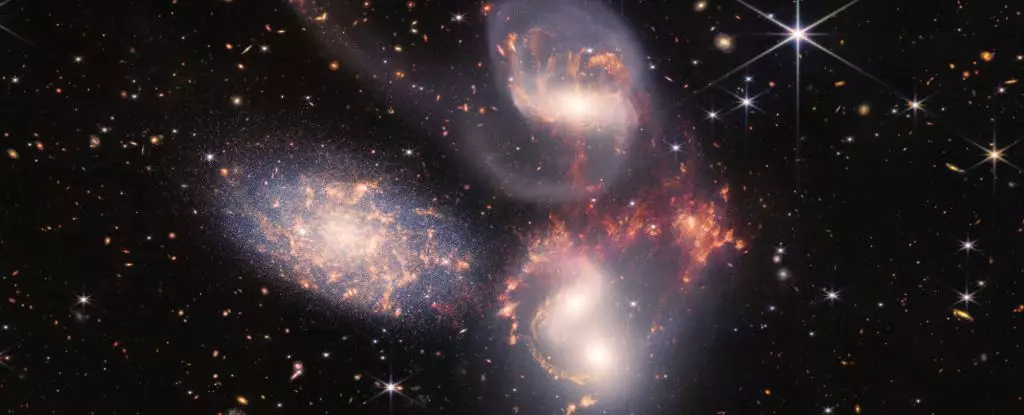In the vast expanse of the universe, approximately 290 million light-years from our little blue planet, an extraordinary phenomenon unfolds: the intricate dance of four interacting galaxies known as Stephan’s Quintet. This cosmic quartet, alongside a fifth galaxy that is merely a line-of-sight anomaly, offers a striking spectacle characterized by the tumult of collision remnants and energetic interactions. Recent observations have illuminated the complexities of these galactic activities, marking a significant step in our understanding of cosmic dynamics.
Stephan’s Quintet has captivated astronomers since its discovery in 1877, essentially operating as a laboratory for studying galaxy formation and interaction. Nestled within this cosmic landscape is a prime actor: one of the four galaxies is barreling through the group at a staggering speed of 3.2 million kilometers per hour (2 million miles per hour). This high-velocity intruder acts like a cosmic wrecking ball, generating phenomena akin to a sonic boom and producing massive shock waves that brighten the space surrounding the galaxies.
Intergalactic Interactions: The Nature of Galactic Clusters
At a glance, Stephan’s Quintet appears as a collection of five galaxies; however, careful analysis reveals a more complicated reality. Among these, only four are genuinely interconnected through gravitational interactions, while the fifth galaxy simply shares our line of sight from a staggering 40 million light-years away—an important distinction that emphasizes our universe’s vastness.
These four galaxies are locked in a gravitational ballet, the results of which span billion-year timescales. The ongoing collisions and interactions generate a vast cloud of gas, which may have been stripped from the galaxies themselves, floating in the intergalactic medium. As these galaxies exert gravitational forces on one another, they churn up material, generating heat and turbulence, leading to a region filled with shocks and energy.
Recent findings from the William Herschel Telescope, particularly utilizing the Enhanced Area Velocity Explorer (WEAVE) wide-field spectrograph in Spain, have unveiled new insights into this chaotic environment. The observations notably focus on the galaxy NGC 7318b, which is rapidly colliding with surrounding gas and creating shock fronts that can rival the size of the Milky Way.
These observations have brought to light new knowledge regarding the nature of gas affected by the NGC 7318b collision. A pivotal discovery is the dual nature of the shocked gas environment. Where the shock front rips through cold gas at hypersonic speeds, it generates brilliant trails of ionized particles. Conversely, shockwaves interacting with hotter gas manifest differently, creating a subtle glow and compressing the gas instead.
According to astrophysicist Marina Arnaudova, the high-speed shockwave rips electrons away from atoms, leaving behind a luminous trail of ionized atoms—a stunning visualization of the power harnessed in such cosmic interactions. By employing different observational tools like radio telescopes, scientists can interpret how these collisions affect all gas phases within the cloud, effectively mapping the energy cascade that results from such frenetic activity.
LOFAR observations have provided another layer of insight, revealing that energized particles have been present for approximately 11 million years. This temporal analysis seems to align with the known timeline of NGC 7318b’s passage through this intricate network of interactions. Consequently, these observations highlight a synchronized ecosystem of gas and energy within Stephan’s Quintet.
The intricate interactions present in Stephan’s Quintet represent a rare opportunity for scientists to study such a dynamic environment so close to Earth. Understanding the evolution of galaxies like our own Milky Way necessitates learning how galaxies collide and coalesce over cosmic timescales. As the research team emphasizes, each nugget of new information gleaned from this captivating cosmic battleground adds to our understanding of the universe’s fabric.
Scientific collaboration, made possible through advanced technology such as the WEAVE instrument, continues to shed light on previously hidden cosmic details. Gavin Dalton, an astrophysicist from the University of Oxford, echoes this sentiment, emphasizing the exceptional detail that modern tools can capture in an environment as tumultuous and richly complex as Stephan’s Quintet.
Stephan’s Quintet serves as a testament to the beauty and complexity of the universe. The ongoing research not only informs our understanding of galactic dynamics but also fuels the insatiable curiosity that drives humanity to look up at the night sky, seeking answers in the vastness of space. As observational technology advances, we can only anticipate the wealth of knowledge that lies ahead, waiting to be uncovered by our collective quest for cosmic truth.

